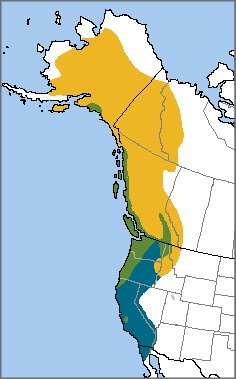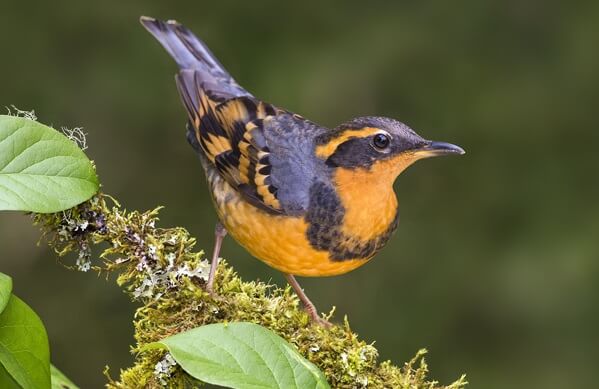 The eerie, ethereal-sounding whistles of the colorful Varied Thrush resound throughout the dense rainforests of the Pacific Northwest, where this bird's haunting song is more often heard than the bird itself is seen. Famed naturalist Louis Agassiz Fuertes called its song "the voice of the cool, dark, peaceful solitude which the bird chooses for its home."
The eerie, ethereal-sounding whistles of the colorful Varied Thrush resound throughout the dense rainforests of the Pacific Northwest, where this bird's haunting song is more often heard than the bird itself is seen. Famed naturalist Louis Agassiz Fuertes called its song "the voice of the cool, dark, peaceful solitude which the bird chooses for its home."
Varied Thrush numbers have decreased significantly over the last 40 years due to habitat loss in the mature and old-growth forests where they nest, alongside species such as Swainson's Thrush, Western Tanager, and Evening Grosbeak. In winter, when Varied Thrushes move downslope into more settled areas, window collisions and free-roaming cats can be significant sources of mortality.
Winter Wanderer
Varied Thrush is a short-distance migrant, unlike many thrush species such as Wood Thrush and Bicknell's Thrush. Varied Thrushes winter along the west coast of North America from Alaska south to Baja California Norte. Some populations move to lower elevations to spend the winter, a phenomenon known as "altitudinal migration." Sometimes individual birds wander far out of their normal range, surprising observers as far afield as the East Coast.
During the winter Varied Thrushes become more sociable, gathering in loose flocks of up to 20 birds that may include this thrush's close relative, the American Robin.
Haunting Song of Old Forests
The male Varied Thrush sings in whistled tones from the tops of live conifers, mainly in the morning and evening. This bird was recorded on its breeding grounds in Seward, Alaska.
(Sound file courtesy Peter Boesman, XC322917. Accessible at www.xeno-canto.org/322917)
Nesting in Temperate Rainforest
Like other thrushes, Varied Thrush feeds on protein-rich insects and other arthropods during the breeding season, then switches to fruit, berries, and acorns in winter. The birds find food by foraging on the ground, usually under dense cover, where they busily flip over leaf litter as they search for prey.
During the breeding season, male Varied Thrushes establish territory by singing and aggressively chasing away other males. The mossy, open-cup nest, built solely by the female, is located in low bushes on or near a stream bank, or in a conifer at the base of a branch against the trunk. Varied Thrushes may raise two broods per season.
Four subspecies of Varied Thrush are recognized, based upon subtle differences in female plumage.
Sign up for ABC's eNews to learn how you can help protect birds

Female Varied Thrush by Wildpix, Shutterstock
Varied Ways to Help a Varied Thrush
Public land protections such as the Northwest Forest Plan are critical to the conservation of the old-growth forests favored by Varied Thrush and to endangered birds such as Northern Spotted Owl and Marbled Murrelet. ABC continues advocacy efforts for these mature forests in the face of ongoing threats.
Currently, the U.S. Congress and the Department of the Interior are proposing to weaken the Migratory Bird Treaty Act (MBTA), which protects migratory birds throughout the Americas — ranging from Varied Thrush to Yellow-billed Cuckoo and Blackburnian Warbler. Take action to help save the MBTA.
Donate to support ABC's conservation mission!



















































